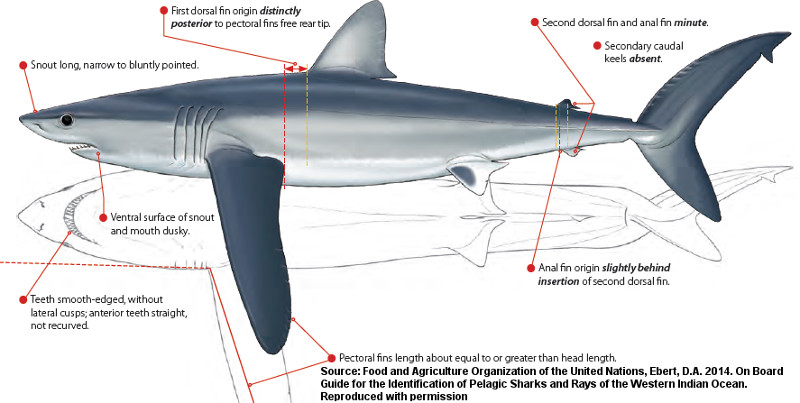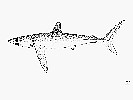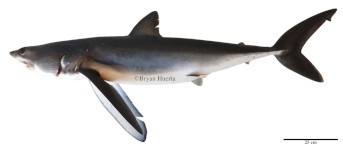Isurus paucus
Guitart Manday, 1966
Longfin mako
Classification: Elasmobranchii Lamniformes Lamnidae
Reference of the original description
Nuevo nombre para una especie de Tiburón del género Isurus (Elasmobranchii: Isuridae) de Aguas Cubanas. Poeyana, Ser. A, 15, 1–9
Nuevo nombre para una especie de Tiburón del género Isurus (Elasmobranchii: Isuridae) de Aguas Cubanas. Poeyana, Ser. A, 15, 1–9
Synonyms / new combinations and misspellings
Isurus alatus, Isurus cf. paucus
Isurus alatus, Isurus cf. paucus
Types
Isurus paucus
XXXX: No types known;
Isurus alatus
Holotype: USNM: 197427; Paratype: USNM: 197429; USNM: 197435;
Isurus paucus
XXXX: No types known;
Isurus alatus
Holotype: USNM: 197427; Paratype: USNM: 197429; USNM: 197435;
Description :
Citation: Isurus paucus Guitart Manday, 1966: In: Database of modern sharks, rays and chimaeras, www.shark-references.com, World Wide Web electronic publication, Version 05/2025
Please send your images of "Isurus paucus" to info@shark-references.com

Isurus paucus Guitart Manday, 1966, © FAO, Food and Agriculture Organization of the United Nations, Ebert, D.A. 2014. On Board Guide for the Identification of Pelagic Sharks and Rays of the Western Indian Ocean. Reproduced with permission, illustration by Marc Dando , Wildlife Illustrator

Isurus paucus Guitart Manday, 1966, © FAO, Food and Agriculture Organization of the United Nations, Ebert, D.A. 2014. On Board Guide for the Identification of Pelagic Sharks and Rays of the Western Indian Ocean. Reproduced with permission, illustration by Marc Dando , Wildlife Illustrator
Common names
 Makohai,
Makohai,  Dientuso prieto,
Dientuso prieto,  Mako aletón,
Mako aletón,  Marrajo carite,
Marrajo carite,  Petite taupe,
Petite taupe,  Longfin mako,
Longfin mako,  Longfinned mako shark,
Longfinned mako shark,  Anequim-preto,
Anequim-preto,  Tubarão,
Tubarão,  Tubarão-anequim-de-gadanha
Tubarão-anequim-de-gadanha
 Makohai,
Makohai,  Dientuso prieto,
Dientuso prieto,  Mako aletón,
Mako aletón,  Marrajo carite,
Marrajo carite,  Petite taupe,
Petite taupe,  Longfin mako,
Longfin mako,  Longfinned mako shark,
Longfinned mako shark,  Anequim-preto,
Anequim-preto,  Tubarão,
Tubarão,  Tubarão-anequim-de-gadanha
Tubarão-anequim-de-gadanha
Short Description
Pectoral fins about as long as head or longer, relatively broad-tipped in young and adults; snout usually narrowly to bluntly pointed, usually not acute; cusps of upper and lower anterior teeth straighter, with tips not reversed [531]. Caudal fin lunate, with a very long lower lobe [20050]. Dark blue above, white below, with dusky markings on underside of snout, around mouth (Ref. 6581).
Pectoral fins about as long as head or longer, relatively broad-tipped in young and adults; snout usually narrowly to bluntly pointed, usually not acute; cusps of upper and lower anterior teeth straighter, with tips not reversed [531]. Caudal fin lunate, with a very long lower lobe [20050]. Dark blue above, white below, with dusky markings on underside of snout, around mouth (Ref. 6581).
Distribution
Western Atlantic: Gulf Stream and Florida, USA; also Cuba. Reported from southern Brazil [20050]. Eastern Atlantic: Guinea, Ghana. Western Indian Ocean: Madagascar. Pacific Ocean: Taiwan, near Phoenix Island, and north of Hawaii [20050]. Source: www.gbif.org
Western Atlantic: Gulf Stream and Florida, USA; also Cuba. Reported from southern Brazil [20050]. Eastern Atlantic: Guinea, Ghana. Western Indian Ocean: Madagascar. Pacific Ocean: Taiwan, near Phoenix Island, and north of Hawaii [20050]. Source: www.gbif.org
Human uses
fisheries: minor commercial; price category: medium; price reliability: reliable: based on ex-vessel price for this species
fisheries: minor commercial; price category: medium; price reliability: reliable: based on ex-vessel price for this species
Biology
Exhibit ovoviparity (aplacental viviparity), with embryos feeding on other ova produced by the mother (oophagy) after the yolk sac is absorbed [733]. With litters of 2-8 pups [518] [2539]. Distinct pairing with embrace [17086]. Born at 97-120 cm TL [2539].
Exhibit ovoviparity (aplacental viviparity), with embryos feeding on other ova produced by the mother (oophagy) after the yolk sac is absorbed [733]. With litters of 2-8 pups [518] [2539]. Distinct pairing with embrace [17086]. Born at 97-120 cm TL [2539].
Remarks
shark-references Species-ID=3295; CITES: (see: Protected Species for more details) Convention on International Trade in Endangered Speciesof Wild Fauna and Flora annex: II; Council Regulation 2017/160 annex: B
shark-references Species-ID=3295; CITES: (see: Protected Species for more details) Convention on International Trade in Endangered Speciesof Wild Fauna and Flora annex: II; Council Regulation 2017/160 annex: B

















